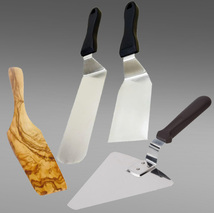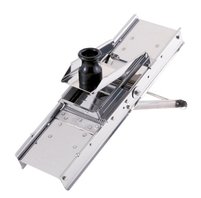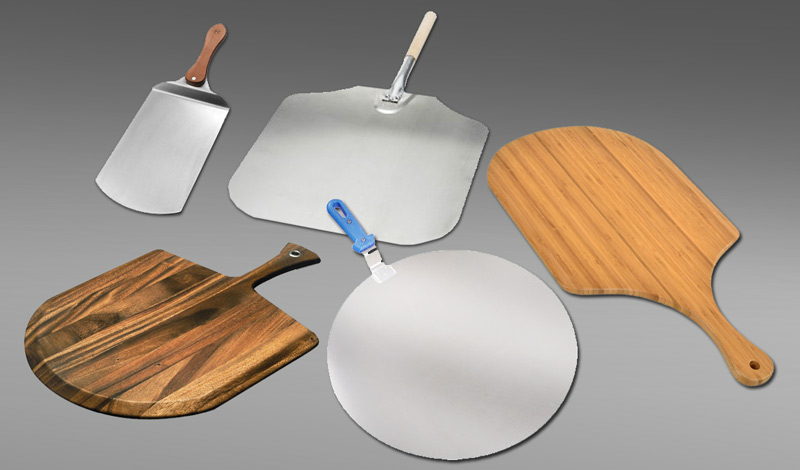|
It's useful to discuss how to put together a great pizza making tool kit before diving right into making pizza. Sure, you can just slap some dough onto a cookie sheet and stick it in the oven, but it won't give you a really good pizza. So, first things first... Flour You really can't make a decent tasting pizza with all-purpose white flour. The amount of proteins and gluten are very different. Instead, use a good quality bread flour like King Arthur's Bread Flour. I've tried others but found this brand to be the most consistent and gives a nice chewy or crisp crust, depending on your recipe and how you handle the dough. I would not recommend Pillsbury Bread flour. It makes a very sticky, somewhat soft crust--too gluey. I also would stock some King Arthur's Whole Wheat flour for times when you want a more robust crust. Mixing in about 1/3 wheat flour makes a great pie with a more dense,earthy crust. I wouldn't use all wheat flour though... the dough gets too elastic making it very difficult to spread out to the size of a larger pie.  Yeast You can make a good pizza with most types of yeast. Packets of ready rise or instant yeast are fine but I prefer to buy mine in larger vacuum packs at a big box store, like BJs. You can also use jars of yeast found in supermarkets, even if it says "bread machine". After all, it's still yeast. I've never found the need for caked yeast when making pizza. For the home pizza maker it's overkill. To prolong the life of any yeast, put it in the fridge. Yeast is alive. Cold prolongs its life and too high a temperature (especially when proofing with water) can kill it. Around 115 degrees Fahrenheit is perfect when proofing. Remember, proofing is when you activate the yeast by adding warm water and a food source, like honey or sugar. If the yeast doesn't proof, it won't rise the dough and you need some new yeast. Counter space You need a good, clear counter to handle the dough on and perhaps space nearby to transfer your dough to a peel and for prep. It doesn't have to be marble or granite, even Formica is fine. I use a wooden board especially made for pastry making. A stainless steel counter would be great. The trick is to flour the surface to keep your dough from sticking as you work with it. And for clean-up, wipe it down with a dry cloth or paper towels. Using only a damp sponge at the end to clear up any dried dough. A bench scraper is also handy for scraping off dried dough (only for wood, marble and granite--not stainless steel or Formica as these might scratch). A clear area about 20" x 20" will do fine. Pizza Stone I think any of the man made pizza stones are great and will be better than jury-rigged methods such as bricks, tiles or slate. Get as large a stone as can fit in your oven. Rectangular is better because you can do any shape or put large sheet pans on it for great heat distribution. Keep in mind to never clean your stone with soap. Just a little water and scrubby to get of any crusted drips. It will also darken in time and help give you a well cooked crust bottom, especially important when doing deep dish or Sicilian pan pizzas with metal pans. (Check the photo below: New stone on left, aged stone on right). I actually have two stones. One is light than the other. I use the darker one when I want a dark bottom and smokier, crispier crust. You can also modify the temperature of your stone for various types of pizza by its position in the oven--top, middle or lowest rack. In every case, preheat your oven at least 20 minutes for the stone to get as hot as possible. And if you want a really crusty pie, spray a little water on the stone so it steams just before placing your dough on it. This replicates a steam oven used to bake crusty breads. A hot pan with some water at the bottom of the oven also helps make a crunchy crust. Pizza Peel The most important tool for making pizzas--the Peel. The wooden type are great for prepping your pizza and then sliding onto your stone, but a thin (metal) peel is best for removing pizzas from the stone. If you get a wood one, make sure it's got a fairly thin, beveled front edge in case you want to use it for removing pizzas. You don't need a long handle unless you have a wood fired pizza oven or are making a lot of very heavy pizzas with lots of toppings. When putting your raw dough onto a wooden board, I'll suggest two methods. A sheet of parchment paper on the board under the dough will slide the prepped pizza onto a stone easily. The parchment will brown a bit but won't burn. The other method is to sprinkle a decent amount of stone ground corn meal (not too fine) on the board. The corn meal acts like little ball bearings so you can slide the loaded dough off onto the stone. I wouldn't recommend using flour. If your dough is a bit sticky it will turn the flour into glue and make it difficult to slide. One more thing... when you make pan pizzas I don't recommend using the peel to remove them. Use oven mitts. Loaded pans easily slide off peels. And when sliding a loaded pizza into the oven, make CERTAIN you have the stone in there first! I forgot once and quickly slid the dough onto the bare rack before I knew what happened. What a mess. I managed to turn it into a large stromboli and saved dinner!  Hand Tools Of course, you need something to cut the pizza. I recommend having two pizza cutters, both small and large diameters. The larger one is best for slicing through heavy pizzas with lots of ingredients. The small diameter cutter would cut closer to the edge of deep dish pans. You can also use a double wheel pastry cutter. You can cut the crusts clear of deep pans with a good kitchen shears. If you want to get fancy, get a long mezzaluna cutter. These cut pizzas with a rocking motion. I use mine for very thick pizzas or focaccia. Another useful tool is a long spatula to lift heavy slices for serving. Lots of toppings make for a slice that can drop onto a diner's lap--you don't want that. I use two basic types: a wood handled stainless steel spatula designed for flipping pancakes (with straight sides) 12 - 20 inches long; and a triangular stainless pie server with wood handle. The first is for rectangular slices, the latter for slices from a round pie. There is even an offset spatula for deep dish pans. If you want to get really rustic, go for an olive wood spatula. Beautiful. (Hint, Hint, Santa!) Pans First of all, you can make pizzas without pans. The basic type I make is prepped on a wooden peel, slide into an oven, then taken out. Done. I use large commercial type flat pans only for serving, never for baking. In fact, you don't even need that... you can serve right from a wooden peel. It even looks rustic, especially if you have browned parchment still under it. I do have various pans for baking, though. I've tried metal flat pans for baking but I don't think the bottom of the crust browns enough. Direct contact with the hot stone is best. I tried one of those perforated pans a couple of times, but I hate that circled grid pattern it leaves on the bottom of the crust--sometimes the pie gets stuck in the holes. One of my favorite pans is a large aluminum round with 1" high sides. I use this when making a large pan pizza--thick crust. Then there are a couple of dark 10" pans for making Chicago style deep dish pies. I also have a dark rectangular pan for Sicilian pies bit I think it can over cook the crust a bit. My favorite for Sicilian pies is a standard half sheet baking pan. In all cases, you need to lightly oil the pans for easy pie removal, and I bake all pan pizzas directly on the stone rather a rack--the bottoms cook better this way.
 Cheese Grater This is essential for grating all sorts of cheese. A basic box cutter with several options for grating or slicing is best. One with rubber along the base will stay put while you grate. A nice large nadle with rubber grip helps too. I use the small pointy holes for grating hard cheese like romano or parmagiano and the 1/4" holes for grating packaged mozzarella, provolone, assagio or my favorite pizza cheese, fontina. Long slits can be used to slide softer cheeses like fresh mozzarella into larger rough slices. I use the 1/8" holes rarely for pizza as it grates "hairs" of cheese that melt down too fast. This side would be OK for topping off a pizza with fresh cheese "hairs". When using fresh mozzarella I either slice or chop it up with a chef's knife or sort of smoosh it into rustic pieces with my fingers.  Mandoline This is optional, but I broke down and got a stainless steel pro model for around $150 a few years back and it opened up new pizza horizons. It's expensive but will last a lifetime, is sharper than my old cowboy boots and is easy to clean with a bottle brush. Once you learn how to use one safely, you can make paper thin slices of sausages, pepperoni, veggies like zucchini, potatoes and more. You can use cheaper models, like the Oxo Good Grips V-Blade--a deal at around $40. This price range has lots of choices, but you want a heavy one (that won't slide around) one that has a good size hand grip, sharp blades and the flexibility to do julienne slicing. Of course it should also be easy to clean and store... some look like they have lots of fussy and dangerous parts to deal with. If it's too finicky you will stop taking it out. That's what I love about mine... take it out, unfold the legs, flip the lever for thickness, start slicing. Once you've had a pizza with paper thin slices of a nice dry sausage or sweet slices of zucchini that cook through perfectly on a four minute pizza, you'll never go back to the knife. Watch your knuckles! --Jerry Finzi P.S. If you like what you've read, please LIKE us on Facebook and SHARE us with your friends who might also be interested. Gratzie!
1 Comment
8/9/2022 07:13:41 pm
I appreciate you sharing your knowledge of baking pizzas in convection ovens and how they turned out unevenly as a result of the fan blowing near to the pizza's back. I'd want to have a pizza party outside for a family gathering. I'll look for the ideal pizza oven to use so that the pizza bakes evenly.
Reply
Your comment will be posted after it is approved.
Leave a Reply. |
Categories
All
Archive
June 2024
|










 RSS Feed
RSS Feed
